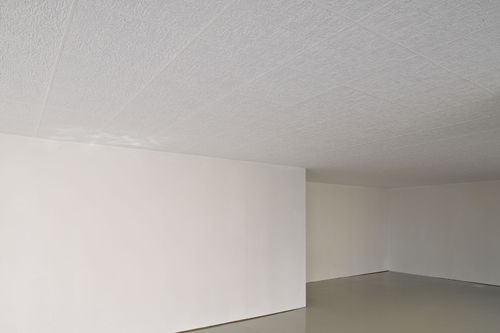Artist:
Knut Henrik Henriksen (born 1970 in Oslo, Norway; lives and works in Berlin, Germany).
Materials:
Wooden beams, planks, and Styrofoam panels.
Description:
“Knut Henrik Henriksen’s works are equally driven by a search for mathematical harmony and potentially endless structures, while also remaining conscious how the introduction of universal standards seem to have fuelled the technical and economic rationalization of late modernism. In the only work in the exhibition this discussion takes form of a deadpan analysis. Lowering the gallery ceiling to Le Corbusier’s idealized 2.26, the architect’s philanthropic ambition of placing man at the centre of building is tested out, but paradoxically done so in a building context that normally places objects at the centre. The anti-septic cleanliness of the gallery is amplified—offering the viewer little more than void and an experience of one’s own scale in relation to the space. The sculpture is rather defined as the space in between the two horizontal layers. Both miming and mocking the whiteness of the gallery space Henriksen is employing white square Styrofoam ceiling panels—bought from a DIY store in the working class area of Berlin. Henriksen keeps returning to these cheap standardized materials from DIY stores—inextricably connected to the tristesse of high-rise office buildings, but also to apartments and the numerous cafés in Henriksen’s home area of Kreuzberg and Neukölln in Berlin. His alterations of this material is kept at an absolute minimum in this work. Rather Henriksen has an interest in the material’s inherent and unadulterated qualities, citing the artist Carl Andre’s early wooden constructions and ‘scatter pieces’ as sources of inspiration.”
—”Knut Henrik Henriksen: Scale of Proportions which makes the Bad Difficult and the Good Easy,” Standard (Oslo).
“‘Scale of Proportions’ finds its point of departure in Le Corbusier. According to the French architect, the ideal height for a ceiling is 2.26 meters—a statistic he derived from the mathematical calculus of the Golden Section. Yet clearly the very notion of an ideal ceiling height is absurd, given that there is no standard height for human beings. This disparity between the ‘ideal’ and the real is clearly exposed when the viewer enters the gallery, for as visitors walk around Henriksen’s space they are articulating their own true heights against Le Corbusier’s model one. In a way, then, the viewer is the fulfilment of the work, the material of Henriksen’s criticism and the appropriation of Corbusier’s utopian vision. Any attempt to define the human experience by means of a standard is, Henriksen seems to imply, both ineffectual and futile, since it will always be undermined by individual experience. Thus ‘Scale of Proportions’ succeeds in standing out among the pantheon of works addressing issues of ’empty spaces’ for its employment of the viewer as the actual point of intervention.”
—Kjetil Roed, review of Knut Henrik Henriksen, Frieze, January 1, 2007.


